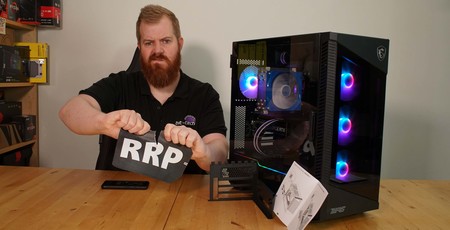Watch Andy go to town on the MSI MPG Velox 100R chassis in the video above.
Key time stamps:
00:33 – Specs
02:36 – Benchmarks
08:45 – Features and Build Quality
28:35 – Conclusion
MSI has been in the PC component business as long as we can remember, and although it’s been making motherboards since being formed in 1986 and graphics cards since 1997, it’s still a relative newcomer to a lot of the markets.
Today we’re looking at one of the latest cases, the MPG Velox 100R, due to be released in late October/early November, along with a more performance-focused 100P Airflow model.
The case stands at 490mm x 474mm x 231mm (HxDxW) so fairly mid-sized for a mid-tower. It has tempered glass front and side panels, although a little on the skinny side at 3mm, and comes with four 120mm ARGB PWM fans and an ARGB LED strip running down the side of the PSU shroud. The design is a little uninspired and looks similar to the many windowed RGB cases on the market today, but it’s also inoffensive and would sit well in many setups.
All the RGB in the case comes attached to a small, simple LED controller behind the motherboard, which can be controlled through a button on the front I/O, or connected to your motherboard via a 3-pin 5v ARGB header, to allow control through your motherboard software. The front I/O also has power, reset, 2x USB 3.0 Type-A and a USB 3.2 Gen 2 Type-C (10Gbps) although these are spread down the right side of the case, so much so that the USB-C port is halfway down and could cause access issues depending upon where you case is situated.
The case unfortunately suffers from some build quality issues. The steel is pretty thin at 0.7-0.8mm for the most part, made all the more flimsy by most panels having any spare space ventilated. Even ones that don’t need it like the top of the PSU shroud are heavily ventilated, despite the only ventilation in the bottom of the case being directly under the PSU. The PSU shroud has a window for you to show off your supply, but it’s partially blocked by the black border of the window and is also very small and will likely cut off most ATX PSU badges.
MSI provides a vertical GPU mount which is thankfully made of thicker steel and offers great support to the GPU, with no noticeable sag. But from there things take a turn for the worse. None of the six standoff placements fit my Corsair PCI-e riser and installation was a real headache. The bracket can’t be installed with the motherboard in place due to bumps on the PCI bracket tabs that slot into the motherboard tray, nor can you install the GPU with the bracket in place, as two of the screws to secure the GPU in place are under the rear fan, too close to use a screwdriver.
Thumbscrews would work, but aren’t provided, so you have to attached the GPU to the vertical mount first, which then blocks the bottom of the motherboard and access to HD audio, USB, fan headers, etc.
At the back things improve a little, because cable management is well-catered-for with the design of the case. There’s 25mm of depth to play with and 24 cable-tie points spread right across the motherboard tray, so all cables, no matter their path, can be neatly tucked in. It’s just a shame MSI only give you two Velcro straps and five cable ties.
You need them tied down tight, too, as the rear panel is only secured to the case at the front and rear edge. I thought it would be a quite a problem at first, nothing to secure potential cable bulge, but in practice it works quite well. The front slotting in first and acting almost like a hinge to swing the door closed and hold it with one hand and securing the self-retaining thumbscrews with the other. Yes, the panel does bulge away a little, but with careful cable management it’s not bad at all and a lot easier than fighting with the traditional style of back-panel fastenings.
For storage there’s a pair of 2.5in drive sleds behind the motherboard that attach on rubber grommets to quell any vibrations from traditional HDDs. The 3.5in bay under the PSU shroud doesn’t fare so well though. The metal frame is paper-thin and would easily be damaged when moving it about, as it can be moved between two different positions, but there’s only 30mm difference between them. It can only fit one drive sled, with a second drive having to be attached direct to the top of the cage, despite there being enough height for a two-sled cage. The sled is a made of cheap plastic with no vibration dampening offered anywhere. It is at least tool-less, but I would suggest employing a screwdriver to remove the cage completely and dispose of it, freeing up room for excess power cables, as there’s precious room anywhere else.
The fans mentioned earlier a generally cheap, too, with the vibration dampening on the corners being foam, not rubber, and already permanently imprinted from the fan mounts. They are quiet at full speed though, with the entire case coming out at 34.1dB in stock fan formation. That stock fan formation of having the front three intakes attached to the outside of the chassis rails was the worst performing though. Simply moving to the back of the fan mounts and away from the glass front decreased CPU temps by 2.4°C and GPU by 1.6°C. Moving two fans to the side intake and adding the third as another exhaust in the roof (bit-tech stalwarts may remember that formation well) proved even better, reducing temps by 2.9°C and 1.8°C, respectively.
The real kicker is the price. With the looks and feels of myriad glass-panelled RGB cases from the likes of GameMax, Aerocool, Deepcool, etc., which sell for £45-£70, MSI want to charge £130. That’s not a typo, MSI really want to charge you double for what I genuinely feel is a £65 case. Even with the inclusion of the vertical GPU mount, price might be pushed up to £75. MSI hasn’t been in the case game long enough to demand that sort of premium, especially with build quality that isn’t exceptional.
Pros
• Good cooling potential
• Full complement of quiet fans provided
• Flexible mounting for fans and rads
• Included vertical GPU mount
Cons
• Fan setup out of box is sub-optimal
• Materials used are thin and cheap-feeling
• 3.5in drive cage and vertical GPU mount poorly implemented
• High price premium





GIPHY App Key not set. Please check settings